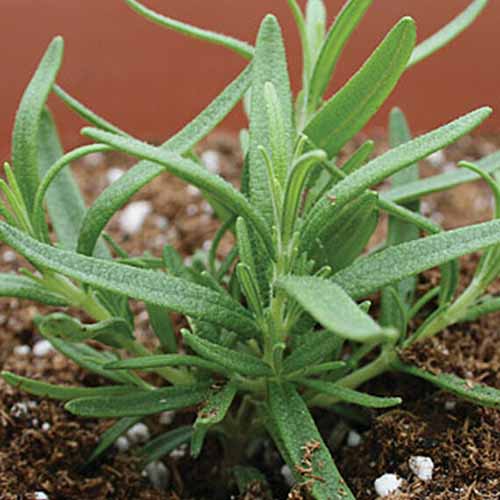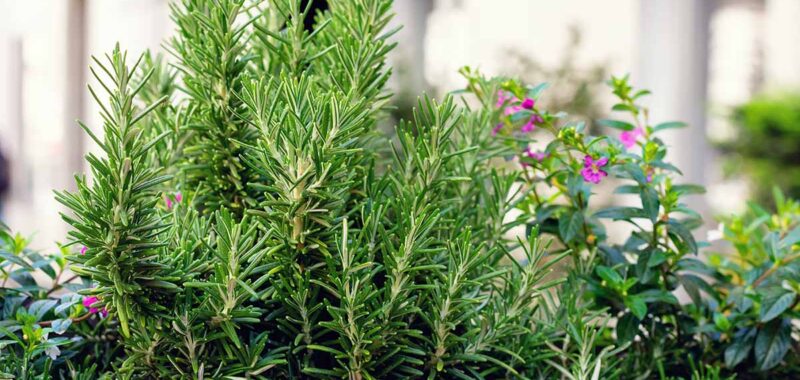Rosemary (Salvia rosmarinus) is one of those herbs that grows all year long in the right conditions, which is good news for those of us who love using it as a seasoning in our favorite dishes.
The name “rosemary” is pretty in itself, but wait until you learn about its roots: “ros,” Latin for “dew,” and “marinus” for “sea” results in combination in the poetic moniker “dew of the sea.”
This name references the herb’s native growth habitat on rocky coastlines along the Mediterranean Sea.


We link to vendors to help you find relevant products. If you buy from one of our links, we may earn a commission.
Luckily for us, this evergreen perennial in the mint family, Lamiaceae, grows splendidly in containers.
With its piney scented needle-like leaves and delicate flush of blue, purple, or pink flowers in the spring, it makes a fantastic addition to any container garden.
In this guide, we’ll cover how to grow rosemary in containers.
Here’s the lineup:
Why Grow Rosemary in a Container?
Rosemary is best suited to cultivation in USDA Hardiness Zones 7-10, and if you live in Zones 5 and 6 you can even find a winter-hardy variety to grow outdoors year-round.
Otherwise, you have to grow the plant as an annual, watching your perfectly healthy and robust plant succumb to nature when the weather turns cold.
Unless, that is, you’re growing it in a container and can simply move it indoors!
Since I live in Zone 4, that’s what I do with my dew of the sea. I like to set it on my front porch in the summer alongside my lavender. The two fragrant herbs provide a lovely backdrop whether I’m coming or going.


If you don’t have space in your garden, don’t have a large outdoor garden in the first place, or simply don’t have a yard at all, growing rosemary in containers is an excellent choice.
The herb is an ideal indoor plant for urban dwellers.
Choosing the Right Container
While S. rosmarinus is a sturdy, robust plant, you’ll want to choose a container that provides optimal growing conditions. For a young plant, select one that’s at least six to eight inches wide and deep.
As a rule of thumb, there should be at least an inch of space in between the sides of the container and the root ball.


Your container can be made of plastic, terra cotta, stone, vinyl, or whatever material you desire.
The most important thing is to make sure it has adequate drainage holes. Consider using a drainage dish if you’re keeping it on a porch or patio so that the water doesn’t drain out directly onto the surface and cause damage.
Rosemary starts losing vitality quickly when its roots sit in water, and when it becomes rootbound, it can’t absorb water and nutrients properly. A pot that drains well is a must.
Fill your chosen container with porous, well-draining potting soil. An organic cactus and succulent soil works well, or regular potting soil amended with one third perlite or builder’s sand.
How to Grow
This low maintenance herb is happiest in a full sun location, but part shade works too, particularly in hot climates.
If you live in a warm, humid area, you can put the container in a location that receives shade during the hottest parts of the day.


Depending on the size of your pot or planter, allow the top inch of soil to dry out between waterings. In the case of small pots, provide water when the top half-inch of soil is dry.
Once established, rosemary is fairly drought tolerant, what it can’t abide is oversaturation.
Rosemary doesn’t need fertilizer in order to thrive, but you can apply a top dressing of well-aged compost in spring. If the leaf tips look dried out and yellowed after the winter, fertilize once in the spring with a balanced 10-10-10 NPK fertilizer.
If you want multiple plants, consider starting your own from seeds or cuttings.
See our complete rosemary growing guide for more tips.
Pruning and Maintenance
Every year or two, you’ll need to either prune the roots of your plant or repot it into a larger container.
Are the roots sticking out of the drainage holes? Is water taking a long time to drain through the soil? These are signs that it’s time for a root trim or new pot.


To prune the plant’s roots, carefully remove the plant from the pot. Take a pair of pruning shears or a knife and cut off the bottom third of the root ball. Make two or three vertical cuts from the bottom of the root ball and cut about a third of the way up the plant.
Repot in a larger container that allows for that one-inch-on-all-sides rule, or in the same one if you’ve trimmed enough roots.
Repot the plant with fresh potting mix and water thoroughly.
To maintain their shape, prune plants in late spring or early summer, removing up to one third of the foliage. In addition, prune away any diseased or broken branches as needed. And pinch off stems here and there to use in your cooking!
Cultivars to Select
You can either grow creeping or upright rosemary, both of which are fragrant. The former looks lovely in a decorative pot, while the latter is preferred for culinary use.
‘Prostratus’ is an excellent creeping variety, while ‘Arp’ is a classic upright.
Here are a couple additional favorite cultivars:
Barbeque
For skewer-stiff stems and robust flavor, plant ‘Barbeque’ in a container to grow outdoors.
Hardy in Zones 8-11, ‘Barbeque’ offers an ever-present garnish for your meals, or simply a beautiful tangle of greenery to look at (and smell).


‘Barbeque’
Untrimmed, it’ll grow and spread anywhere between 48-60 inches and produce pretty blue flowers.
You can find a set of three plants available at Burpee.
Blue Boy
This dwarf cultivar grows just 24 inches tall and wide, making it easier to grow in a container.
‘Blue Boy’ is hardy to Zones 8-11 and boasts delicate purple-blue blooms.
Pests and Disease
This hardy herb doesn’t suffer from much in terms of pests and disease. I’ve grown it right next to delphiniums that were being attacked by aphids, but none ever touched my pungent rosemary. The herb can even repel certain types of aphids.
Your main concern is powdery mildew, a fungal infection that grows as a thin, whitish layer of mycelium on the needle-like leaves. To prevent an infection, make sure you avoid overwatering and place the plant in full sun with adequate air circulation.
Root rot may be a problem if the potting mix isn’t well-draining or has become oversaturated from excessive rain or overwatering.
Best Uses
Rosemary is an excellent addition to a patio or porch herb garden, and it shines in a variety of dishes.


I love to enjoy a few mouthwatering rosemary and parmesan crackers as an afternoon snack. You can find the recipe on our sister site, Foodal.
Or, make these delicious, grilled rosemary and garlic burgers, also from Foodal, for a savory lunch or dinner.


Do you have more of a sweet tooth? Then try some rosemary butter cookies from Foodal – they are fragrant, decadent dreams come true.
Of course, you can always use the herb as decoration, too, or have plants as ornamentals on a sunny patio or balcony to provide both fragrance and eye-pleasing charm.
Rose(mary)-colored Glasses
No matter how you grow and enjoy it, this herb is sure to improve your life with its flavor, scent, and looks.


Since it’s fuss-free and resilient, it’s a perfect plant for beginner gardeners (and blossoming chefs).
Are you growing rosemary in a pot or planter? Let us know in the comments section below!
And in the meantime, check out these other articles on growing herbs in containers to add to your collection:



